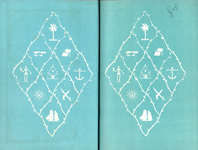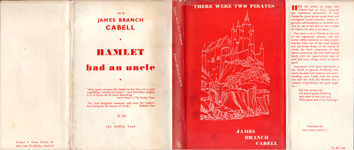James Branch Cabell : An Illustrated Bibliography
THERE WERE TWO PIRATES; a Comedy of Division
Hall Code |
Description |
TWTP-B1(E) |
First English Printing 1947 |
COMPILATION
Full Title:
A COMEDY OF DIVISION | There Were | Two | Pirates | James Branch Cabell | With Illustrations by | John O'Hara Cosgrove II | THE BODLEY HEAD | London (see image above).
Publication:
London: John Lane The Bodley Head Limited. "First published 1947" (see image above).
Collation:
12mo [18½ cm (7 3/8 in.) x 12½ cm (5 in.)] consisting of pp. xii + 115* as follows: (i) Half-title; (ii) Works by James Branch Cabell; (iii) Title page (see image above); (iv) Dedication; (v) frontispiece (see image above); (vi) list of contents; pp. ix-xii Editorial Note; Illustrations pp. 14, 28, 44, 78, 106; Fly titles pp. 13, 27, 43, 77, 105; Text pp. 15-25 (verso blank), 29-42, 45-75 (verso blank), 79-103 (verso blank), 107-127.
* Unusually, the text numbering includes the prefatory material, so that page numbers in arabic numerals begin with p. 15.
Binding:
Light cloth. All edges trimmed. Red lettering in two diagonal rows on spine: There Were Two Pirates | James Branch Cabell | followed by Bodley Head device of intertwined "bh" at base of spine (see image above).
Frontispiece:
Line drawing of two figures on stone bridge with short verse below, "Did ever pirate roll | His soul in guilty dreaming, | And wake to find that soul | With peace and virtue beaming?" (see image above).
Dedication:
On p. (iv): FOR MARJORIE KINNAN RAWLINGS | Who more than any other person has given | fame to the old ways of Florida; whose | actual home is beyond the City Gates; and | whom I am proud to rank as a friend (see image above).
Dust Jacket:
Spine and front panel red with white lettering, rear panel white with red lettering (see image above).
Endpapers:
Front endpapers turquoise with diapered figures in white (see image above), clearly derived from the decorations on the endpapers in the American printings. However, the rear pastdown is plain white, and there is no free endpaper at the rear; the pages end with p. 127. We examined two different copies of this printing, and both are identical. Perhaps this was a post-war economy measure?
Notes:







